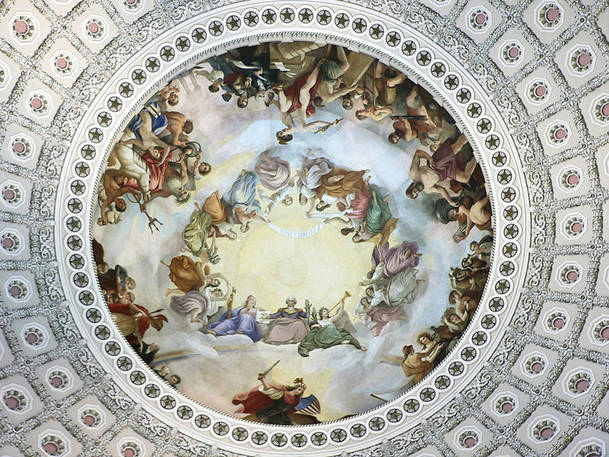


Yesterday Congress bestowed its highest award, the Congressional Gold Medal of Honor, in memory of “America’s Michelangelo,” Constantino Brumidi, [2] the great Italian-Greek artist who painted the frescoes in the U.S. Capitol in Washington, D.C. “As a grandson of Italian immigrants, I am proud that Congress has decided to honor Brumidi’s memory with its most important distinction reserved for worthy individuals,” declared New Jersey Congressman Bill Pascrell. Along with Wyoming Senator Michael Enzi, Pascrell was the first to sign the proposal which requires support from two thirds of the representatives to be approved.  The measure will now have to be signed by President George W. Bush. This is the 213th gold medal that Congress has awarded. The first was given by George Washington in 1776, and it will be exhibited in the Capitol’s Visitor Center. The son of an Italian and a Greek, Constantino Brumidi immigrated to the United States in 1952. He studied with famous artists and decided to leave Italy for political reasons. Arriving in New York, he soon became well-known in artistic circles and was then commissioned to paint the Capitol’s frescoes. His most important work of art is “The Apotheosis of Washington” which adorns the dome. He also painted most of the major events in American history which decorate the base of the dome. His other works are found throughout the building, on the west wing named the Brumidi Corridors, and in the reception rooms of the Senate and the president. In the summer of 2005, Pascrell and Senator Hillary Clinton initiated the approval of a resolution that authorized the use of the Capitol’s Rotunda to commemorate the two hundredth anniversary of the artist’s birth. Present at the ceremony were the Congressional leader, politicians, historians, and representatives of the Italian and Greek communities in America.
The measure will now have to be signed by President George W. Bush. This is the 213th gold medal that Congress has awarded. The first was given by George Washington in 1776, and it will be exhibited in the Capitol’s Visitor Center. The son of an Italian and a Greek, Constantino Brumidi immigrated to the United States in 1952. He studied with famous artists and decided to leave Italy for political reasons. Arriving in New York, he soon became well-known in artistic circles and was then commissioned to paint the Capitol’s frescoes. His most important work of art is “The Apotheosis of Washington” which adorns the dome. He also painted most of the major events in American history which decorate the base of the dome. His other works are found throughout the building, on the west wing named the Brumidi Corridors, and in the reception rooms of the Senate and the president. In the summer of 2005, Pascrell and Senator Hillary Clinton initiated the approval of a resolution that authorized the use of the Capitol’s Rotunda to commemorate the two hundredth anniversary of the artist’s birth. Present at the ceremony were the Congressional leader, politicians, historians, and representatives of the Italian and Greek communities in America.
Source URL: http://test.iitaly.org/magazine/focus/art-culture/article/gold-medal-honor-in-memory-constantino-brumidi
Links
[1] http://test.iitaly.org/files/brumidi1213249808jpg
[2] http://en.wikipedia.org/wiki/Constantino_Brumidi
[3] http://www.dossena.org/tiziano/arte/arte_brumidi.html